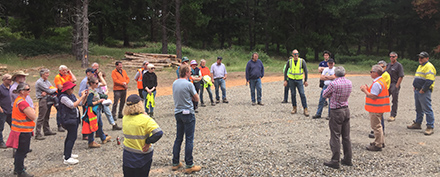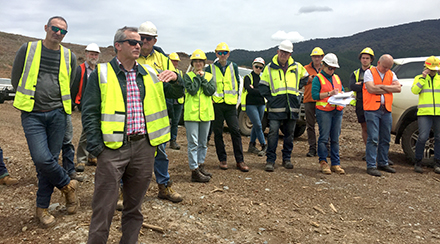The Murray Valley timber catchment holds great potential for forestry plantation growth and offers a viable solution to shoring up future timber supply for housing and construction following the Black Summer bushfires, according to a professional forum held in the region last month. Source: Timberbiz
Forestry Australia, an independent association of forestry scientists, professionals and growers, convened the forum to discuss how best to maintain and expand forest-based industries in north-east Victoria and the southwest slopes region of NSW.
Fifty people attended from across the plantation industry, including growers, contractors and large timber processors. The forum considered land access, processing capacity and key risks for the sector in this region.
Participants also took part in a field trip to forests in the Myrtleford area for a firsthand look at replanting after the fires, the complexities of salvage harvesting and innovations in harvesting steep slopes that improve environmental outcomes while reducing costs.
Chair of Forestry Australia’s Victorian Division Rod Keenan said the forum highlighted the great potential for plantation growth in the Murray Valley.
“Plantation-based timber industry within the region directly provides an estimated $540 Million per year in value-adding (contribution to Gross Regional Product). These industries are already major contributors to the economy and communities of north-east Victoria, and they offer significant potential for growth,” he said.
“Growing national and global demand for wood products presents one such opportunity, however expansion of the sector is currently limited by availability of timber resources.
“No new plantations have been established in the region for nearly 30 years and wildfires, including the 2019-20 Black Summer fires, have impacted on short term wood supply capacity.
“In order to capitalise on the opportunities in the Murray Valley and counteract the threats, the forum put forward a number recommendations for action by the industry and Victorian and local governments.”
The recommendations include:
- Build on the participants’ vision for the sector to be recognised as the lead industry in the region with more plantations and trees on farms with a greater diversity of ownership
- Communicate the value of the industry for employment and for regional and national economies, the risks under business as usual, and opportunities to expand the sector contribution in NE Victoria
- Support innovation to increase efficiency and maximise value from all parts of harvested trees and products
- Develop new tree growing partnerships and relationships with local farmers
- Improve transparency for harvest and haulage costs and mill-gate log prices
- Nurture the next generation of industry participants through training, skills and mentoring
- State and federal governments to provide policy, incentives and planning to support the vision.
Prof. Keenan said the sector had demonstrated considerable resilience following the Black Summer fires, with plantation managers, harvesters, haulers and processors working together to salvage and process an estimated 3.5 Million tonnes timber from about 47 000 ha of burnt plantation, over the last 18 months.
This salvage process has created new levels of cooperation, new log standards and new market opportunities, in the face of the loss of major export markets.







